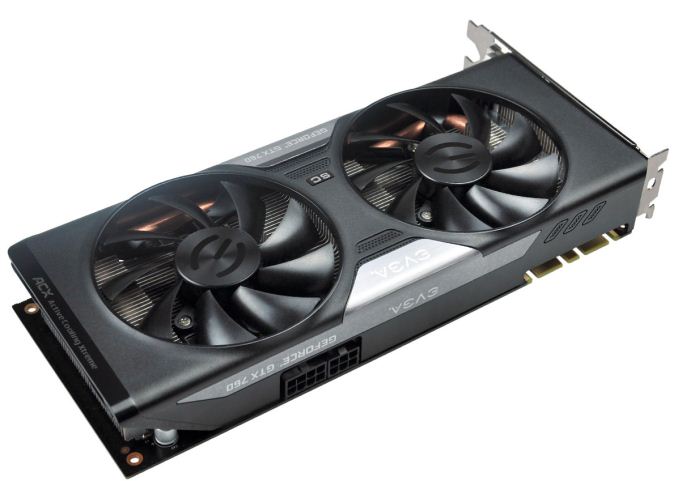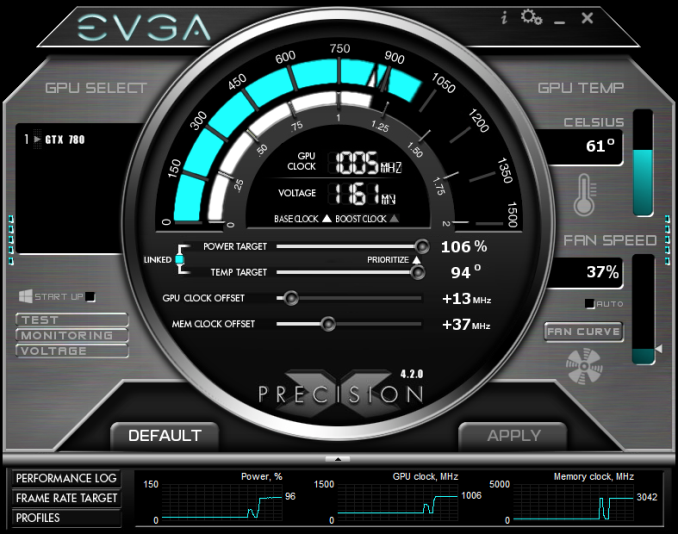The GeForce GTX 760 Roundup: Gigabyte and EVGA Compared
by Ryan Smith on October 7, 2013 2:00 PM ESTEVGA GeForce GTX 760 Superclocked ACX
Our other card for this roundup is EVGA’s GTX 760 Superclocked ACX. This card is a fully custom card, utilizing a custom EVGA PCB in conjunction with EVGA’s recently launched ACX cooler. All of this is then wrapped up with a moderate factory overclock that sees EVGA ship the card at 1072MHz core, 65MHz (9%) over the GTX 760 reference clockspeeds.
Like the 780SC ACX and 770SC ACX cards we’ve looked at previously, the 760SC ACX marks the first time we’ve seen EVGA’s new ACX cooler in this category of product. The ACX cooler is a notable departure from the norm for EVGA, who previously did not seriously involve themselves in the branded custom cooler market. With the ACX cooler EVGA is not only looking to tap into that market, alongside the larger market for open air coolers, but the company is looking to make a name for themselves based on build quality of their cooler, something EVGA’s competitors don’t always invest as heavily in and/or call as much attention to.
At its most basic level, the ACX cooler is a typical dual fan open air cooler, as we’ve seen countless times from other manufacturers. This basic design is very effective in moving large amounts of heat for relatively little noise, making the usual tradeoff of moving some of the cooling workload onto the system’s chassis (and its larger, slower fans) rather than doing the work entirely on its own. In EVGA’s case they’re using larger than typical fans for a dual fan cooler, with the ACX cooler’s fans coming in at 90mm diameter.
Meanwhile everyone has their own slight variations in design here, with EVGA focusing on running a full length heatsink to maximize their heatsink surface area. The heatsink itself is single segment heatsink with 3 large copper heatpipes from the center of the heatsink and the GPU around to each end of the heatsink. An aluminum baseplate is present on the card, but it only covers the rear half of the PCB which is sparse on components. The MOSFETs and other power delivery components are located near the front of the card, with cooling provided by the primary heatsink itself.
As for EVGA’s quality angle, the company is paying specific attention to the fans on their ACX cooler, using a fan blade design they say is optimized for strength and weight, while driving those fans with a double ball bearing motor. Much like the basic double fan design, ball bearings aren’t a major innovation in this space, but they are inconsistently used, often going unmentioned or interchanged with traditional sleeve bearings from one generation to the next. Mechanically speaking, compared to sleeve bearings, ball bearings typically have greater longevity and a bit less noise under heavy load, in exchange for a bit more noise at idle, making them a good tradeoff for a high-end card. From a practical point of view the longer lifespan of ball bearings will be the greatest gain out of this, while any noise tradeoffs are secondary as the fan itself will usually be the greater factor.
Cooling and factory overclock aside, the 760SC ACX is otherwise typical for a retail GTX 760 card. At 9.5 inches long for both the PCB and heatsink, this is the shorter of the two cards we’re looking at today, and marks the first time we’ve seen the more compact version of the ACX cooler; EVGA’s other cards were an inch longer. I/O is also standard with NVIDIA’s display I/O configuration of 2x DL-DVI, 1x HDMI, and 1x DisplayPort 1.2. Like Gigabyte, EVGA is over-delivering on power in their design; the 6pin + 8pin external PCIe power connectors will have no trouble delivering enough power for this card.
Rounding out the package is EVGA’s usual collection of software and hardware accessories, including a pair of PCIe power adapters and a DVI to VGA adapter. As far as EVGA’s software goes there’s little to be said that we haven’t said before: EVGA still shares the gold standard for software, with their fantastic Precision X overclocking utility and their OC Scanner X artifact scanning utility. Despite being based on the same RivaTuner core as MSI’s Afterburner, Precision X has diverged from Afterburner a bit over time, but as far as base overclocking and monitoring functions are concerned Precision X is among the best. And EVGA’s OC Scanner X software is second to none.
Meanwhile, as with all of EVGA’s North American cards, the 760SC ACX comes with EVGA’s standard 3 year transferable warranty, with individual 2 or 7 year extensions available for purchase upon registration, which will also unlock access to EVGA’s step-up upgrade program. Finally, the MSRP on the card is $259, $10 above the MSRP for the standard GTX 760. However with a $10 mail in rebate active as of the time this was written, it brings the card down to $249, the MSRP of the stock GTX 760 and $10 cheaper than the Gigabyte card. As a result the card is something of a no-brainer within EVGA’s lineup, as it leaves little reason to purchase the non-Superclocked version of their GTX 760 ACX. On a final note, EVGA is also running a Rise of the Triad promotion right now alongside NVIDIA’s Batman: Arkham Origins promotion. So the card comes with a pair of free games instead of just the one.


















22 Comments
View All Comments
hags2k - Monday, October 7, 2013 - link
I like the design of the GB card and really do think it's superior, but I've grown to really love EVGA's software package and have made use of their transferable warranty twice already - the "added value" really is value in this case. It's a tough call!Subyman - Monday, October 7, 2013 - link
I have a MSI TF 760 and couldn't be happier. I compared them all when they first came out and the MSI and GB were the quietest and coolest. I was very pleased with the quality especially considering the price. Would live to see the MSI represented.Teizo - Monday, October 7, 2013 - link
Not sure why you guys didn't include the MSI 760 Gaming, or the ASUS Direct CU. I guess you didn't have them on hand.ShieTar - Tuesday, October 8, 2013 - link
Since the 760 is showing consistently >80% of the performance of a 770, at 60% of the cost, and since NVIDIAs drivers seem to handle framepacing in SLI mode quiet well now, I would really love to see some performance tests for a set of 760s in SLI. Could you please add those tests?Impulses - Tuesday, October 8, 2013 - link
Yeah SLI 760s seem like a terrific value, faster than any single card by a good margin and cost effective enough as to make the 770 a bit irrelevant... I'm trying to decide whether to get two 760s, as an upgrade from my 6970 x2 setup, or save up for 780 x2...Nfarce - Tuesday, October 8, 2013 - link
Guru3D has just such an animal of a review dating from this past June. Just Google "GeForce GTX 760 SLI" and you'll see the link right up there at the top two or three links that come up. The only downside is they don't review all the games (no BF3, no Crysis 3, no Far Cry 3 specifically). But it beats the Titan in Tomb Raider & Bioshock Infinite by 13-18% at 2560x1440. Very nice bang for the buck.idiot consumer - Sunday, October 13, 2013 - link
It is nice to see new gear coming out BUT:There are probably 50% of nvidia card owners with famous: "video driver stopped responding and has recovered"
There is no cure nor solution from nvidia or micro$oft.
The only solution is to buy new card until it happens again.
Forums all over the world are full of complaints.
How come that mayor reviewers like AnandTech could not care less?
Galidou - Sunday, October 13, 2013 - link
If they start to cover driver issues, both company wouldn't want their video card reviewed. The point here is to show the performance, not the possibility of various bugs/problems unless they're critical, BUT:I have a gtx 660ti for a year now and the problem has cursed me for a long time. It is/was worse in some games. I fixed part of it going to an earlier driver. I had a 6870 + 6850 in crossfire(I thought if I had any problem with crossfire I could disable it and play with the 6870) and never had a trouble with them, EVER.
idiot consumer - Sunday, October 13, 2013 - link
If they start to cover driver issues, both company wouldn't want their video card reviewed. The point here is to show the performance, not the possibility of various bugs/problems unless they're critical,Considering that nvidia suffered class lawsuit - in US only - unfortunatelly and has settled it confirms that issues are critical.
Good old days of excellent nvidia cards have gone forever.
I shall never buy from nvidia anymore.
Ryan Smith - Monday, October 14, 2013 - link
We report on things we see first hand and things we can reproduce. And right now we can't reproduce any NVIDIA driver stability issues (and not for a lack of trying).